
I agree Our site saves small pieces of text information (cookies) on your device in order to deliver better content and for statistical purposes. You can disable the usage of cookies by changing the settings of your browser. By browsing our website without changing the browser settings you grant us permission to store that information on your device.
The metabolic exploration platform performs specific on-demand experiments as well as comprehensive metabolic analyses with primary and secondary phenotypic screens to evaluate the energy balance in vivo.
Screens are performed either under basal conditions or through energy challenges using standardized techniques for the detection of phenotypes in energy metabolism, glucose homeostasis, bone metabolism, renal function and inflammation. It provides users with techniques and scientific support to design experimental protocols as well as for the development of new techniques to investigate metabolism.
The metabolic exploration platform has a large expertise in phenotyping mouse model for diabetes, obesity and atherosclerosis.
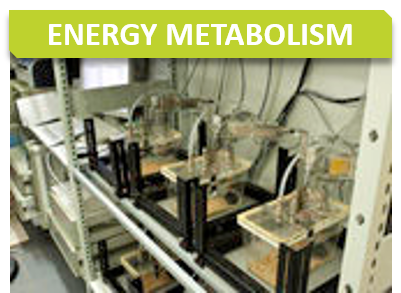

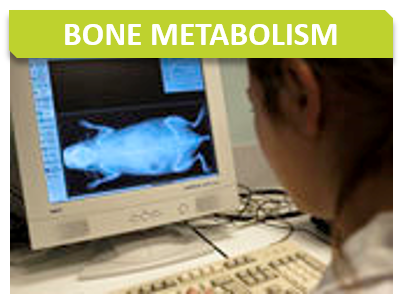
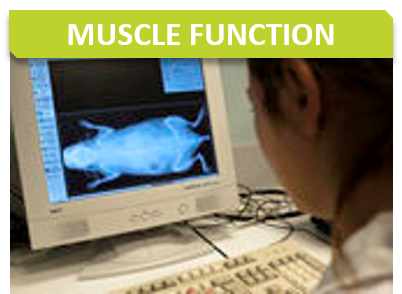
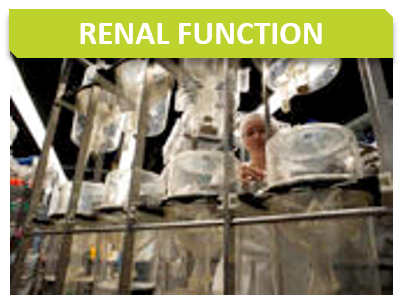

Body composition for fat, lean and free body fluid is evaluated on conscious mice by quantitative nuclear magnetic resonance on Minispec analyzer.

Body composition analysis of male mice from different common laboratory strains after provision of chow diet (CD) or 10 weeks provision of high-fat diet (HFD), including complete body weight, fat tissue content, and lean tissue content. Dramatic increases in fat tissue is seen upon HFD-diet treatment for most strains excepting BALB/c, consistent with what has previously been reported.
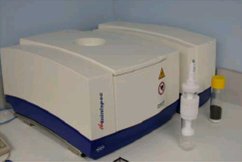
Body composition is evaluated by Quantitative Nuclear Magnetic Resonance (qNMR) using Minispec+ analyzer (Bruker BioSpin S.A.S., Wissembourg, France)
Core body temperature is affected by numerous physiological changes including systemic inflammation, altered nutrient consumption, and physical exertion. Due to circadian changes in body temperature, it is important to measure at regular times of day.
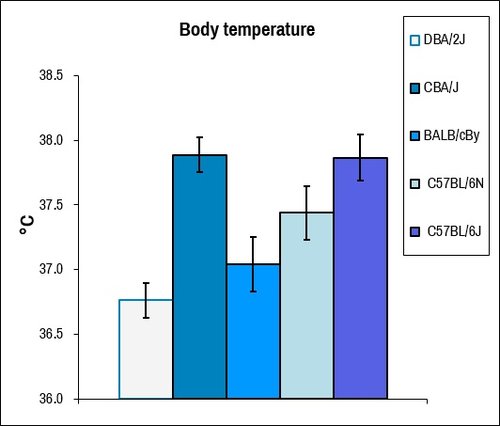
Comparison of core body temperature between males mice (N=7) of commonly used laboratory strains determined by digital rectal thermometer.
The energy content of stools is evaluated in a bomb calorimeter (C503 control, IKA).The assay provides the energy digested by mice and then indirectly the intestinal function. The energy digested is calculated by the difference between the total calories ingested and excreted in faeces.

Analysis of parameters in bomb calorimetry demonstrates increased food efficiency in C57BL/6J mice compared to C57BL/6N mice.
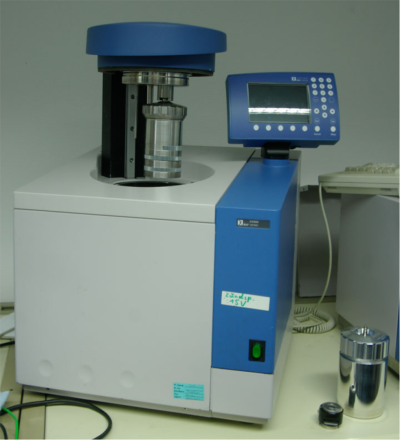
C5000 Bomb Calorimeter (IKA, Staufen, Germany).
The tolerance to cold stress evaluates thermoregulation.
Mice are housed in individual cages during 6 hours at 4°C in a cold room. Body rectal temperature is measured with a probe every hour on each mouse.
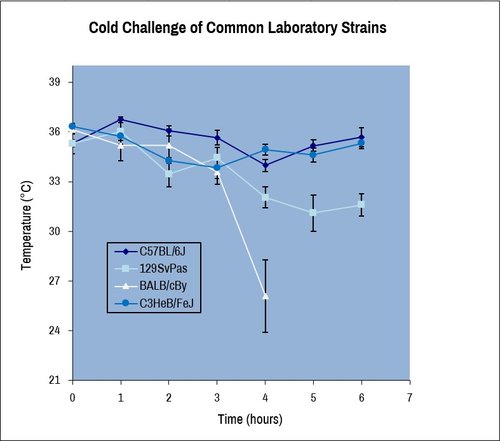
Cold temperature challenge of male mice from different common laboratory strains demonstrates strain-dependent thermoregulation response.
Food consumption is measured by manually weighing remnants of food in the feeders. The test gives precise or estimated evaluation of energy intake in mice depending of whether the animals are singly or socially housed. Food consumption (and water consumption) may also be assessed more accurately in metabolic cages or in polymodal indirect calorimetry monitoring system.
Exercise performance is assessed by treadmill exercise using a defined protocol with increase in speed and incline until exhaustion. The duration of running and the total distance covered evaluates the performance of the mice.
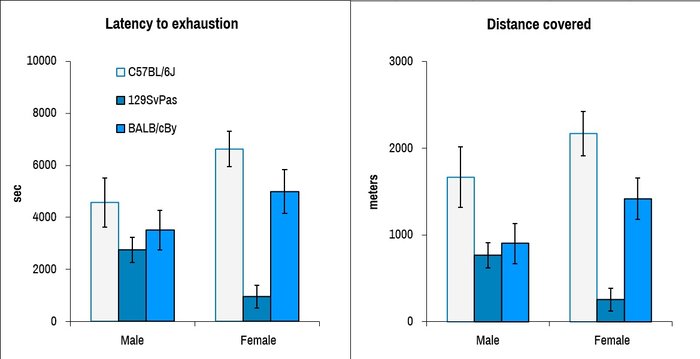
Forced exercise performance of male and female mice of three common laboratory strains were assessed at a constant speed. The results are expressed as a function of time (latency) or distance.
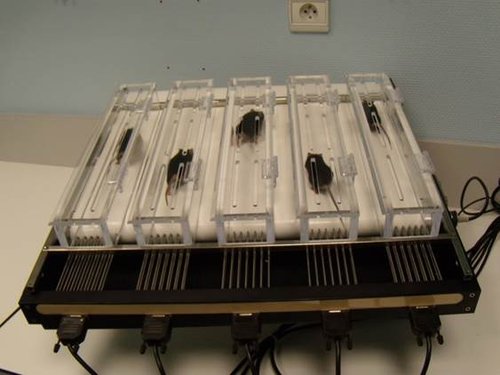
Treadmill device for mice (5 lanes) (BIOSEB, Vitrolles, France).
Calorimetry cages allow the simultaneous measurement of energy expenditure, ambulatory activity as well as food and water intake. Energy expenditure is evaluated through indirect calorimetry by measuring oxygen consumption with an open flow respirometric system. It also monitors CO2 production, thus the respiratory exchange ratio (RER) and finally heat production can be calculated. Infra-red frames are integrated to the system in order to measure ambulatory activity. A food intake monitoring system is also integrated for the measurement of feeding/drinking behaviors.
Experiments can be performed from 24h to 5 consecutive days.
The test can be conducted at different ambient temperature (4°C to 39 °C) and the cages allow one to performing food and drink restriction procedures as well as food or drink preference assays.
See our Indirect calorimetry dedicated section for more details.
Muscle contractility and muscle force can be evaluated in situ on limb muscle using an isolated muscle test system (Aurora Scientific). This procedure is done on anesthetized mice, animals are sacrificed at the end of the measurement.
Renal function may be assessed by metabolic cages. Metabolic cages allow separate collection of urine and feces. The mouse is confined in an enclosure with a wire grid floor for up to 72 h. In parallel, food and water intake are recorded daily by weighing the food and water containers.
Renal function may be evaluated through the measurement of clinical chemistry parameters in 24 hours urine collection. Some models of renal failure / hypertension could be proposed to test drugs.
Feces are collected for the measurement of heat loss by calorimetric bomb.
Metabolic and diuresis cages (Line 3, Techniplast).
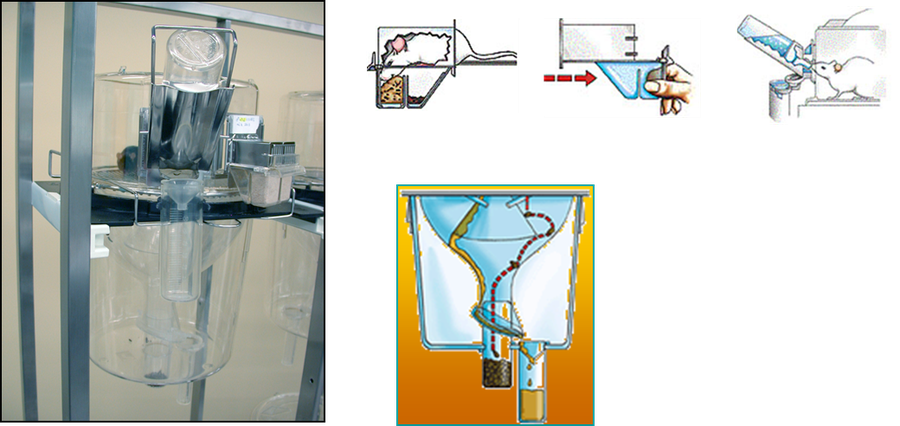
8 mice per group are recommended for reliable data analysis.
Calorimetry cages allow the simultaneous measurement of energy expenditure, ambulatory activity as well as food and water intake. Energy expenditure is evaluated through indirect calorimetry by measuring oxygen consumption with an open flow respirometric system. It also monitors CO2 production, thus the respiratory exchange ratio (RER) and finally heat production can be calculated. Infra-red frames are integrated to the system in order to measure ambulatory activity. A food intake monitoring system is also integrated for the measurement of feeding / drinking behaviors.
Polymodal indirect calorimetry at different temperature: altered temperature is one of the most basic metabolic challenges available. By positioning our indirect calorimetry cages in an insulated, temperature-regulated environment, we can perform cold and heat challenges with polymodal measure of body temperatures, activities, and heat.
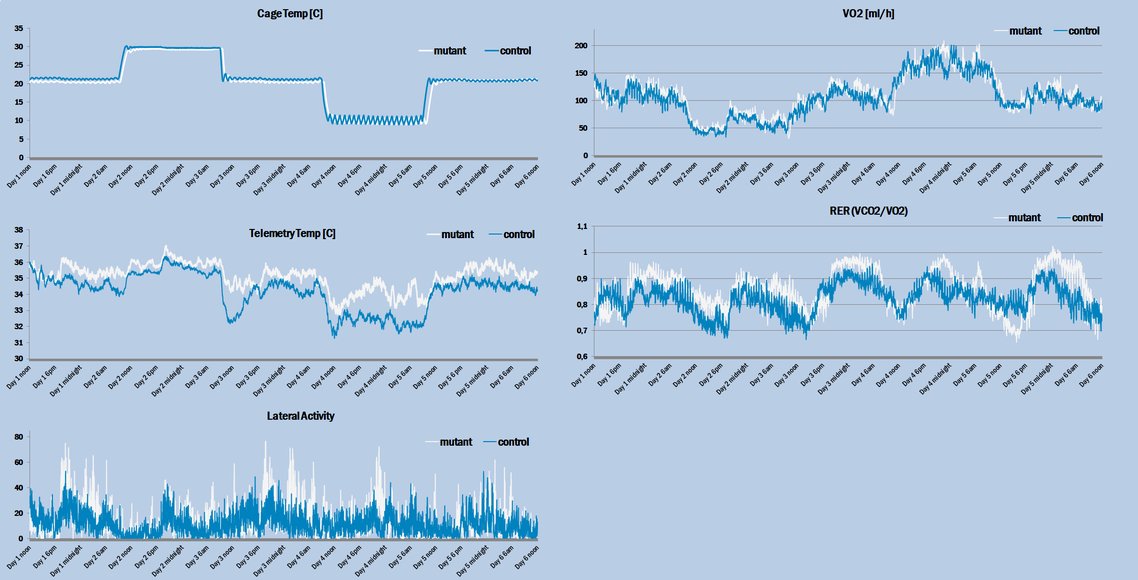
Sample experimental data for comparison between mutant (grey) and control (blue) mice (N=5 per group) at 20°C, 30°C, and 10°C thus defining the impact of elevating and reducing ambient temperature. Cage temperature, peritoneal temperature (by telemetry), lateral activity, and gas measures were collected for each minute across several days.
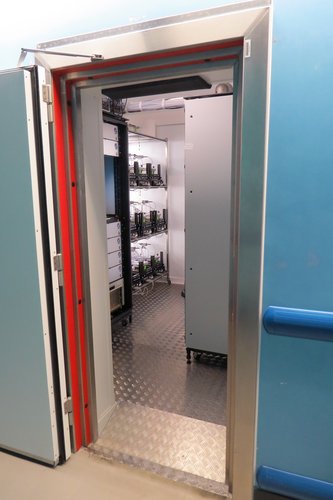
Home cage system Phenomaster/Labmaster (24 cages) (TSE LabMaster systems GmhB, Bad Homburg, Germany).
The High-Resolution Digital Radiography system (Ultrafocus by Faxitron) gives very precise images of the skeletton. Analysis of the digital X-ray pictures is generally performed with respect to bones from the head (zygomatic bone, maxilla, mandibles), teeth, scapulae, clavicle, ribs (number, shape, fusion), pelvis, vertebrae (numbers, shape and potential fusion of cervical, thoracic, lumbar, pelvic and caudal ones), limb bones (humerus, radius, ulna, femur, tibia), joints, digits and syndactylism.
In dual-energy x-ray absorptiometry mode (DXA), the system measures bone mineral density (BMD) and also determine lean and fat mass percentages.
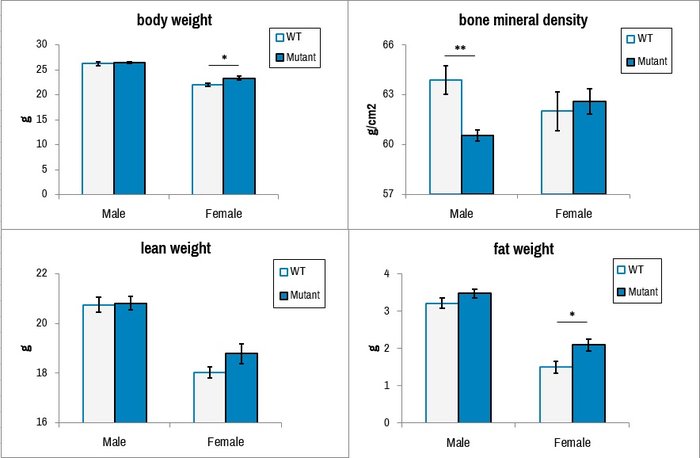
Comparison of wild-type C57BL/6N (WT) and Ttc39a deletion (Mutant) mice for noted body composition parameters by non-invasive Ultrafocus DXA imaging. *, p<0.05; **, p<0.01.
We can procure and provide a high fat diet for obesity, diabetes and steatosis induction. Normally this challenge is most effective in male mice and proceeds for approximately 15 weeks for full effect of challenge.
With several months notice, we can procure and provide a variety of different restriction diets for nutritional analyses in conjuction with our other analyses.
We can procure and provide a high sodium diet for vascular, renal, and cardiac challenges.
Alterations in insulin sensitivity (resistance or hypersensitivity) can be revealed on the basis of an insulin sensitivity test. However a more reliable quantitative analysis is performed using the Euglycaemic Hyperinsulinemic clamp technique. In this procedure insulin is administrated to raise plasma insulin concentration while glucose is infused to maintain euglycaemia. The glucose infusion rate needed to maintain euglycaemia is a reflection of insulin action in the whole body when both glycemia and hyperinsulinemia are set at constant. A femoral vein catheter is placed under anaesthesia 3 days prior to the experiment. The test is conducted on 5h-fasted vigil and not restrained mice.
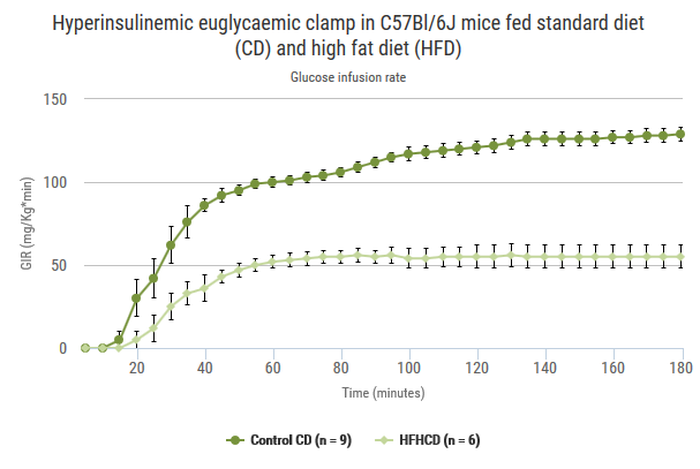
The glucose tolerance test is commonly used to assess the ability of standardized glucose bolus to induce hyperglycaemia. The glucose is either administrated by oral gavage or by intra peritoneal injection. The blood glucose level is measured at different time points after administration.
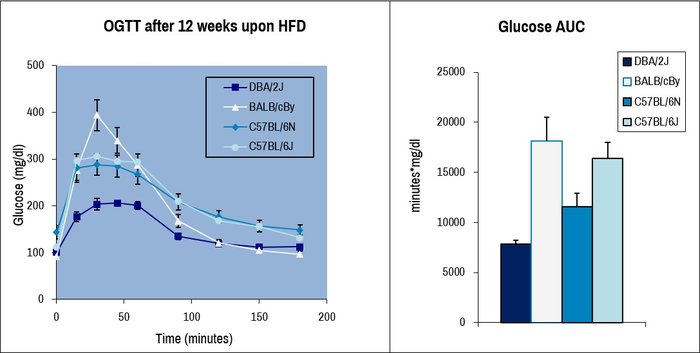
Oral glucose tolerance tested on male mice of four common laboratory strains after provision of high-fat diet (HFD) for 12 weeks. Evolution of blood glucose over time (left panel) and glucose area-under-the-curve (AUC) summaries detect strain-specific difference in HFD response and glucose tolerance.
The insulin sensitivity test is used to measure the regulation of the glycemia by the whole body after injection of a standardized insulin load. Blood glucose is measured at different time points over 90 minutes after the administration using blood glucose monitor and glucose test strips.
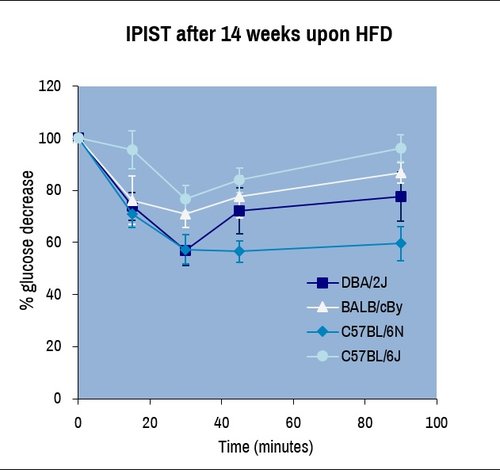
Intraperitoneal-administered insulin sensitivity tested (IPIST) on male mice of four common laboratory strains after provision of high-fat diet (HFD) for 14 weeks. Evolution of blood glucose over time detect strain-specific difference in HFD response and glucose homeostasis.
The Apoe targeted mutation mice (Apoe -/-) are unable to produce apolipoprotein E which is essential for the transport and metabolism of lipids. These mice have a markedly altered plasma lipid profile compared to normal mice, and rapidly develop atherosclerotic lesions. A diet high in fat and cholesterol increases the incidence of atherosclerosis in these mice and this model is a useful model especially for pharmacological studies.
Mice deficient in low density lipoprotein receptor (Ldlr) have an elevated serum cholesterol level and display very high levels when fed a high fat diet. This model is also commonly used for hyperlipidemia and atherosclerosis research.
Tests proposed:
The tolerance to cold stress evaluates thermoregulation.
Mice are housed in individual cages during 6 hours at 4°C in a cold room. Body rectal temperature is measured with a probe every hour on each mouse.

Cold temperature challenge of male mice from different common laboratory strains demonstrates strain-dependent thermoregulation response.
Dextran-sulphate sodium salt (DSS) provision in drinking water elicits a reversible colonic abrasion and inflammation. This is proposed as a first-line examination where inflammatory stimulation may be dysregulated.
We can procure and provide a high fat diet for obesity, diabetes and steatosis induction. Normally this challenge is most effective in male mice and proceeds for approximately 15 weeks for full effect of challenge.
With several months notice, we can procure and provide a variety of different restriction diets for nutritional analyses in conjuction with our other analyses.
We can procure and provide a high sodium diet for vascular, renal, and cardiac challenges.

Selected parameters from metabolic cage collection used to analyse renal function of C57BL/6J mice upon provision of diets with different sodium (Na) content. Standard diet = 0.25% Na+; Low Na diet = 0.03% Na+; High Na diet = 3% Na+. Error bars reflect ± SEM.